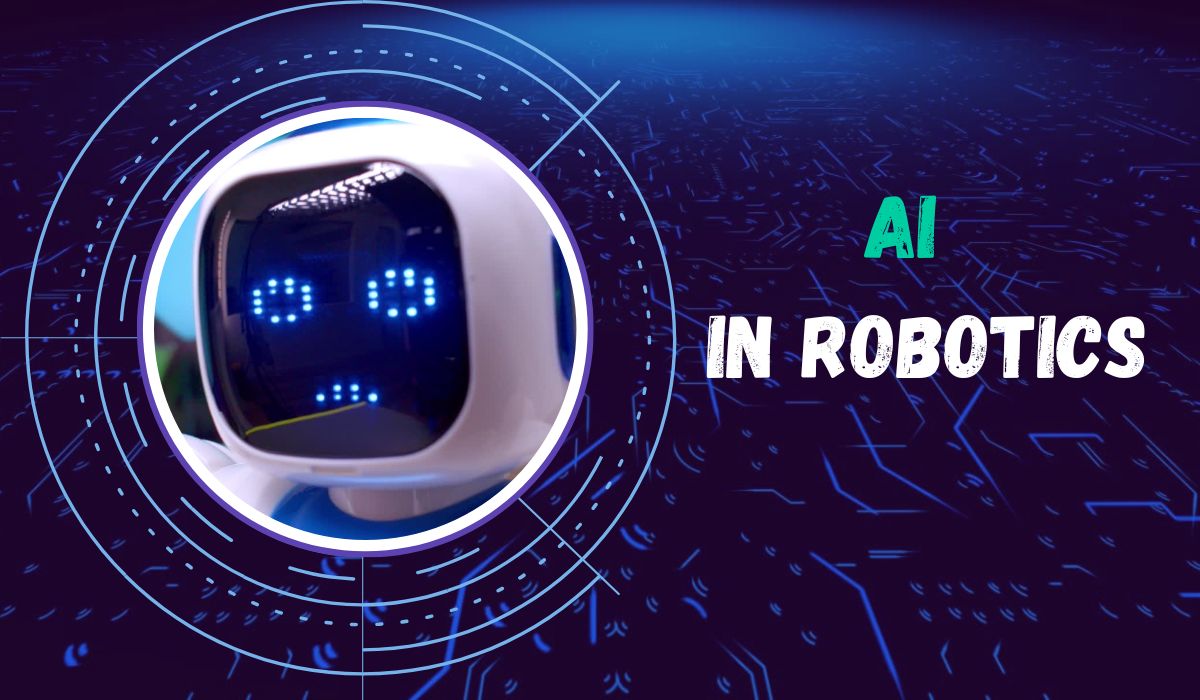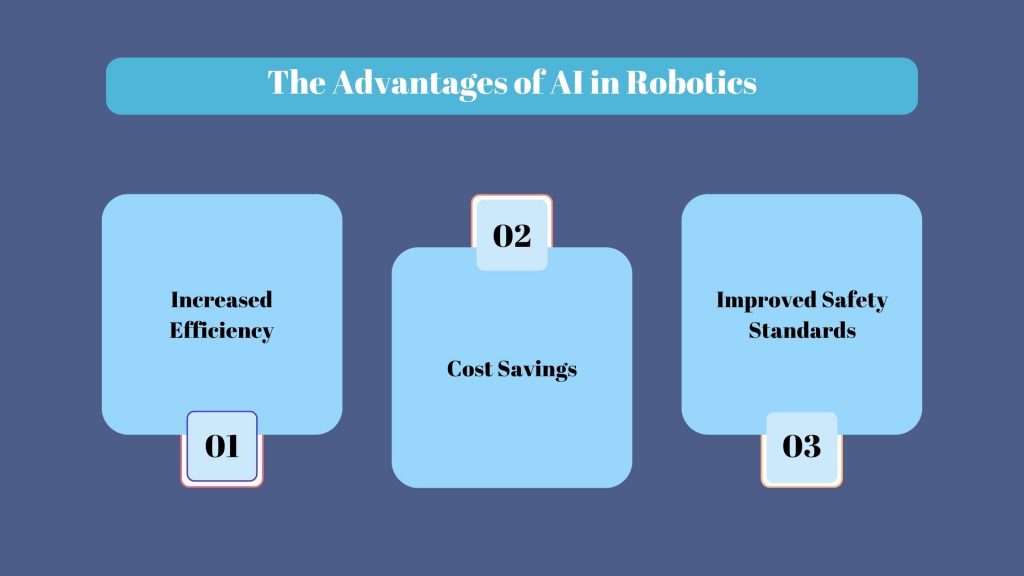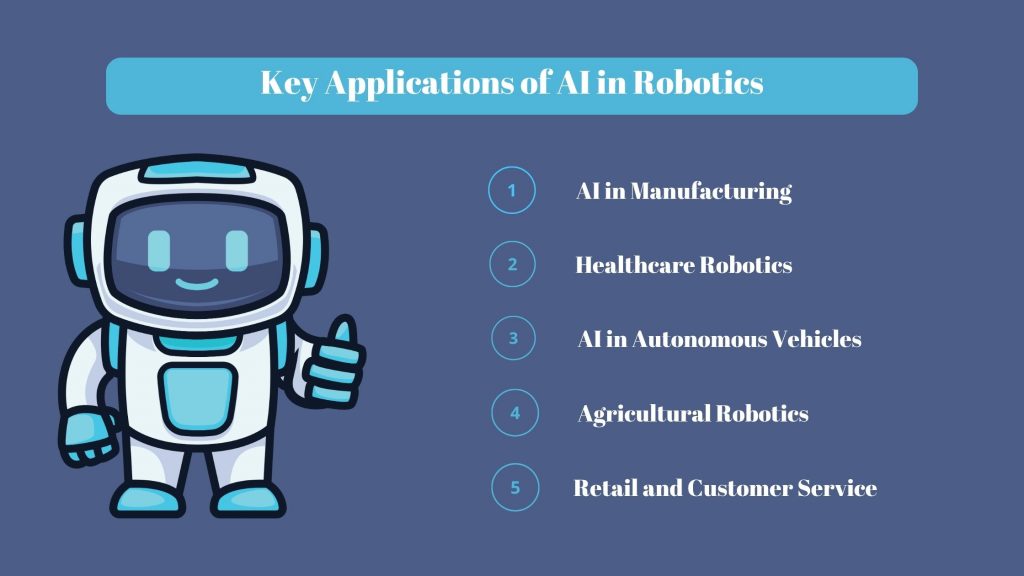
A Practical Guide to AI in Robotics for Modern Industries

AI in robotics is revolutionizing a wide range of industries by enabling smart, automated systems that perform seamlessly—even in highly complex environments. The fusion of artificial intelligence services with robotics has significantly boosted the capabilities of machines, allowing them to think, adapt, and operate with greater autonomy. This integration is not just about better performance—it’s about unlocking new possibilities in automation that drive higher productivity, greater precision, and improved user experiences. According to a report by MarketsandMarkets, the Artificial Intelligence Robots Market is expected to grow from USD 6.9 billion in 2021 to USD 35.3 billion by 2026; it is expected to grow at a CAGR of 38.6% during the forecast period highlighting its rapid adoption across sectors like healthcare, manufacturing, and agriculture.
In this comprehensive guide, we’ll explore how AI and machine learning work hand-in-hand with robotics to create intelligent, autonomous systems that are reshaping the future of industries.
What is AI in Robotics?
AI in robotics is the application of artificial intelligence technologies to build machines capable of performing tasks on their own—or with minimal human input. These intelligent systems use a combination of AI algorithms, machine learning models, and real-time sensory data to perceive their surroundings, analyze information, and make informed decisions. What sets them apart is their ability to learn from experience and adapt to new situations, reducing the need for constant human oversight.
Are Robotics and Artificial Intelligence the Same Thing?
Although robotics and artificial intelligence often work together, they’re not the same thing. Robotics is a field of technology that focuses on designing and building physical machines—robots—that can interact with the real world. Artificial Intelligence (AI), on the other hand, is all about creating systems that can think, learn, and make decisions, much like humans do.
When you combine AI with robotics, you get intelligent machines that can not only move and perform tasks but also understand their surroundings, make decisions on the fly, and adapt to changes in real time.
Here’s a quick comparison to break it down further:
Focus:
- Robotics centers around the mechanical design, movement, and control of machines.
- AI focuses on data analysis, decision-making, and enabling machines to learn from experience.
Key Components:
- Robotics relies on components like actuators, sensors, and control systems to enable physical interactions.
- AI involves algorithms, data processing, and machine learning models to drive intelligent behavior.
Goal:
- Robotics aims to execute specific tasks based on pre-programmed instructions.
- AI aims to create autonomous systems capable of adapting and making decisions on their own.
The Evolution of Robotics with AI
Robotics has come a long way—from simple, repetitive machines to intelligent systems that can learn, adapt, and make decisions on their own. Initially developed to handle routine tasks in industrial settings, robots were once limited to predefined actions with little to no flexibility. But with the rise of AI, robotics has undergone a dramatic transformation.
Early Robotics
In the early days, robots were built to perform repetitive tasks with speed and precision. These first-generation machines were mostly used in manufacturing environments—think assembly lines—where consistency mattered more than adaptability. While highly efficient, these robots couldn’t respond to changes or learn from their surroundings.
Integration of AI Technologies
The game-changer came with the introduction of AI. By integrating technologies like machine learning, computer vision, and natural language processing, robots evolved into much more than mechanical tools. Today’s AI-powered robots can process data, learn from experience, and adjust their actions based on real-time feedback. This shift allows them to function effectively in dynamic, unpredictable environments—from warehouses and hospitals to farms and disaster zones.
According to businesswire, worldwide spending on robotics systems and drones is projected to reach $241.4 billion by 2026, largely driven by advancements in AI integration.
How AI Enhances Robotics Capabilities
Artificial intelligence takes robotics to the next level by integrating powerful technologies like machine learning, computer vision, and natural language processing. Together, these tools enable robots to recognize patterns, understand their environment, and interact naturally with humans. As a result, robots can now perform a wider variety of tasks on their own—making them far more adaptable and efficient across different industries.
According to PwC, AI could contribute up to $15.7 trillion to the global economy by 2030—with robotics playing a major role in sectors like manufacturing, logistics, and healthcare.
Machine Learning
Machine learning gives robots the ability to improve their performance over time by learning from data. Instead of needing detailed programming for every task, robots use algorithms to spot patterns, predict outcomes, and fine-tune their actions. For example, warehouse robots use machine learning to figure out the most efficient paths for moving goods—saving time, energy, and resources.
Computer Vision
With computer vision, robots can “see” and interpret the world around them. By analyzing visual inputs such as images and video, they can identify objects, track movements, and safely interact with their environment. This capability is critical for tasks like autonomous driving, robotic surgery, and real-time surveillance.
Natural Language Processing (NLP)
Natural language processing allows robots to understand and respond to human speech. This is especially useful in customer-facing roles where robots need to carry on conversations, answer questions, or follow voice commands. Whether it’s a support bot in a retail store or a digital assistant in a smart home, NLP helps bridge the communication gap between humans and machines—making interactions more intuitive and seamless.
The Advantages of AI in Robotics

AI in robotics brings a wide range of benefits, from boosting operational efficiency to enhancing safety and cutting costs. By automating tasks that would otherwise require human effort, AI-powered robots are transforming industries with improved reliability, consistency, and productivity.
Increased Efficiency
One of the most significant advantages of AI in robotics is its ability to work non-stop—without the need for breaks or rest. AI-driven robots can perform tasks continuously, ensuring a steady output with unwavering accuracy. This is especially valuable in industries like manufacturing and healthcare, where precision and uptime are critical.
Cost Savings
While the upfront cost of AI-powered robots might be substantial, the long-term savings they offer make them a worthwhile investment. Automation reduces reliance on manual labor, cuts down on errors, and increases overall productivity, leading to lower operational costs. Moreover, robots can help reduce material waste, further cutting expenses in manufacturing and other sectors.
Improved Safety Standards
By taking on high-risk tasks, such as handling hazardous materials or working in dangerous environments, robots help mitigate workplace injuries and ensure safer conditions. Industries like construction, chemical manufacturing, and mining can particularly benefit from AI in robotics, as it reduces human exposure to dangerous situations.
Difference Between Robotics and Artificial Intelligence
While robotics and artificial intelligence are closely related, they serve distinct functions. Robotics is about building machines that can perform physical tasks, whereas AI focuses on creating systems capable of simulating human intelligence. When combined, these fields allow for the creation of intelligent robots that can interact autonomously with their surroundings.
Here’s a comparison of their core differences:
- Primary Function:
- Robotics focuses on performing physical tasks, such as lifting, assembling, or moving objects.
- AI is designed for executing cognitive tasks, like learning, decision-making, and problem-solving.
- Core Components:
- Robotics relies on mechanical systems, sensors, and actuators to carry out physical actions.
- AI depends on algorithms, neural networks, and data processing to simulate human-like intelligence.
- Level of Interaction:
- Robotics operates based on predefined programming or control, making it limited in its ability to adapt.
- AI systems are designed to learn from experience and adapt over time, allowing for more flexible interactions.
- Human Role:
- Robotics typically requires human input for programming, maintenance, and operation.
- AI systems, on the other hand, can independently adjust and learn from data without direct human intervention.
- Applications:
- Robotics is primarily used in areas like manufacturing, medical devices, and drones for physical tasks.
- AI is used in applications such as virtual assistants, data analysis, and decision support systems.
- Dependency:
- Robotics can function without AI for simpler, predefined tasks that don’t require decision-making or adaptation.
- AI often requires hardware (like robots) for physical interactions with the world.
- Data Usage:
- Robotics mainly interacts with physical data through sensors and feedback mechanisms.
- AI is heavily reliant on digital data, using it to process information and improve its operations.
- Flexibility:
- Robotics is less adaptive without AI, sticking to basic functions unless AI is integrated.
- AI is highly adaptable and improves with more data, enabling systems to become smarter and more capable over time.
Although robotics and AI are distinct technologies, their combined power greatly enhances functionality and potential. Robotics focuses on building machines designed to perform physical tasks, from assembling products to assisting in surgeries. These robots are often highly specialized and execute predefined instructions unless they are equipped with AI capabilities.
On the other hand, AI is centered around developing cognitive abilities such as learning, decision-making, and problem-solving. Unlike robotics, which depends on mechanical and electrical components, AI relies on computational models and data processing to simulate intelligence. AI algorithms analyze vast amounts of data, draw conclusions, and continuously adapt based on new information.
When AI is integrated into robotics, it transforms these machines into more adaptive and intelligent systems, enabling them to make decisions and interact with their environments more effectively. However, despite their synergies, each field maintains its own focus and strengths—robotics with its focus on physical tasks and AI with its ability to bring cognitive functions to machines.
Key Applications of AI in Robotics

AI is revolutionizing robotics by expanding its applications across various sectors. From enhancing productivity in manufacturing to improving patient care in healthcare, AI-powered robots are becoming indispensable in many industries. Below are some key areas where AI in robotics is making a significant impact:
AI in Manufacturing
AI-powered robotics is a driving force behind the rise of smart manufacturing. These robots can operate continuously, 24/7, executing tasks such as assembling, welding, and performing quality inspections with impressive precision. Machine learning algorithms enable these robots to adapt to variations in production lines, minimizing downtime and boosting overall productivity. With AI, manufacturing processes become more efficient and flexible, accommodating changes in demand and design.
Healthcare Robotics
In the healthcare sector, AI-equipped robots play a critical role in assisting surgeons, aiding in patient rehabilitation, and supporting elderly care. These robots are equipped with advanced technologies like computer vision and machine learning, which allow them to analyze medical data in real-time. This enhances the accuracy of surgeries, making them less invasive, and accelerates rehabilitation processes, improving recovery times for patients.
AI in Autonomous Vehicles
Self-driving cars rely heavily on AI-powered robotics for navigation, obstacle detection, and decision-making. These autonomous systems utilize computer vision, machine learning, and sensor data to navigate through dynamic traffic environments, ensuring passenger safety and reducing the potential for human error. As autonomous vehicles continue to evolve, AI helps them make smarter, safer decisions on the road.
Agricultural Robotics
In agriculture, AI-driven robotics is enhancing productivity through autonomous machinery like tractors, drones, and harvesters. These robots use AI to monitor crop health, identify the best harvest times, and even manage planting and watering tasks. By automating these processes, agricultural robots contribute to better resource management and increased yields, while also helping reduce labor costs.
Retail and Customer Service
Intelligent robots are increasingly being used in retail environments to assist customers, manage inventory, and streamline shopping experiences. These robots use Natural Language Processing (NLP) to interact with customers, answer their queries, and guide them through stores. In addition, they can conduct stock checks and monitor inventory, enabling retailers to improve operational efficiency and enhance customer satisfaction.
Challenges and Limitations of AI in Robotics
While AI in robotics offers numerous benefits, there are also several challenges and limitations that need to be addressed for its widespread adoption. These include high development costs, technical complexities in integrating AI with robotics, and ethical concerns surrounding data privacy and usage.
High Development Costs
The development of AI-powered robots requires a significant investment in research, development, and testing. The costs associated with acquiring advanced hardware, developing specialized software, and hiring expert talent can be prohibitive, especially for smaller companies. This financial barrier limits the accessibility of AI-driven robotics to only large organizations or those with considerable resources.
Technical Complexities
Integrating AI into robotics is a technically complex task that demands deep expertise in both robotics and machine learning. The robots must be programmed to handle a wide range of tasks and adapt to varying real-world environments. Ensuring that these robots function smoothly requires extensive testing and fine-tuning, which can be both time-consuming and resource-intensive. Overcoming these technical hurdles is crucial for ensuring the reliability and efficiency of AI-driven robots in diverse applications.
Ethical and Privacy Concerns
AI-powered robots rely heavily on large datasets, which raises important questions about data privacy and ethical use. In sectors like surveillance, for instance, balancing the need for security with respect for individual privacy is a delicate issue. Industries must ensure that the data collected by robots is handled responsibly, protecting users’ privacy while still providing the benefits that AI can offer. Addressing these ethical concerns is vital for the continued development and acceptance of AI in robotics.
Future Trends in AI Robotics
As AI robotics continues to evolve, several exciting trends are shaping the future. These developments promise to make robots more adaptable, collaborative, and capable of performing a wider range of tasks across diverse industries.
Collaborative Robots (Cobots)
One of the most promising advancements in AI robotics is the rise of collaborative robots, or cobots, which work safely alongside humans. Unlike traditional robots that operate in isolated environments, cobots are designed to assist human workers by performing tasks such as heavy lifting, assembly, or precision work. Their ability to interact safely and effectively with humans in shared spaces will lead to increased efficiency and productivity in industries like manufacturing, healthcare, and logistics.
AI-Driven Decision-Making
As AI algorithms continue to improve, robots will be able to make real-time decisions and adapt to complex, dynamic environments. With enhanced decision-making capabilities, robots will be able to perform more sophisticated tasks that require quick adjustments, such as navigating crowded spaces or managing unexpected changes in a production line. This will significantly improve the autonomy and flexibility of robots, making them even more valuable in various sectors.
Advanced Mobility Solutions
The future of AI robotics also includes advanced mobility solutions, enabling robots to navigate more challenging terrains. This includes robots that can traverse rough outdoor environments, such as construction sites, farms, or disaster zones, and even adapt to different types of terrain, from slopes to obstacles. Enhanced mobility will make robots more versatile, allowing them to perform tasks in environments where traditional robots might struggle.
Why Choose BigDataCentric for AI Robotics Solutions
At BigDataCentric, we take pride in delivering custom AI-powered robotics solutions that are specifically designed to address the unique needs of your business. Our team, made up of experts in both robotics technology and AI integration, works tirelessly to ensure that your operations are not only efficient but also safe and innovative.
When you partner with us, you gain access to the latest advancements in robotics and AI technologies, backed by our unwavering commitment to quality and performance. We don’t just provide solutions – we help you unlock the full potential of AI robotics to enhance your productivity and drive innovation within your organization.
Ready to Revolutionize Robotics with AI?
We offer tailored AI-driven solutions for robotics to enhance automation, overcome challenges, and optimize operations. Let us help you lead with innovation.
Contact Us Now!
Conclusion
The integration of AI in robotics is ushering in a new era of automation and intelligent systems that are revolutionizing industries across the board. From boosting efficiency in manufacturing to transforming healthcare and agriculture, AI is the driving force behind a smarter and more connected world.
While challenges such as high development costs and ethical concerns still exist, the future of AI in robotics holds immense promise. With limitless opportunities for growth and innovation, we can expect AI-powered robots to continue shaping the future, delivering new capabilities, and improving the way we work and live.
FAQs
-
How is AI used in robotics?
AI is used in robotics to enable decision-making, learning, and adaptation. It powers functions like machine learning, computer vision, and natural language processing to create robots capable of complex tasks.
-
What are the three key applications of AI in robotics?
Manufacturing automation, healthcare assistance, and autonomous vehicles are key applications.
-
What are the benefits of AI in robotics?
Increased efficiency, cost savings, and improved safety are among the primary benefits.
-
Can AI-powered robots replace human jobs?
While AI-powered robots can take over certain tasks, they often complement human workers by handling repetitive or dangerous jobs, allowing people to focus on more complex roles.
-
What is the future of AI in robotics?
The cost varies depending on the project's complexity, with significant investments required for custom development and integration.
-
What is the cost of implementing AI in robotics?
The cost varies depending on the project's complexity, with significant investments required for custom development and integration.

About Author
Jayanti Katariya is the CEO of BigDataCentric, a leading provider of AI, machine learning, data science, and business intelligence solutions. With 18+ years of industry experience, he has been at the forefront of helping businesses unlock growth through data-driven insights. Passionate about developing creative technology solutions from a young age, he pursued an engineering degree to further this interest. Under his leadership, BigDataCentric delivers tailored AI and analytics solutions to optimize business processes. His expertise drives innovation in data science, enabling organizations to make smarter, data-backed decisions.
Table of Contents
Toggle